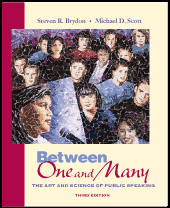 |
 |
 |
 |
 |
![]()
Volume 5,
Issue 2, Winter 2002
|
Between One and Many: The Art and Science of Public Speaking Brydon, Steven R. and Scott, Michael D.Mayfield, 2000 463 pages Paperback: $50.50 US |

|
Reviewed by: Nichola
D. Gutgold, Penn State Berks-Lehigh Valley College
Printer-friendly PDF
version
The most significant debate whirling around basic course texts, is the one proposed by Todd S. Frobish in his article titled “Jamieson Meets Lucas: Eloquence and Pedagogical Model(s) in The Art of Public Speaking (2000). Unless living in a cave, one knows that The Art of Public Speaking has reigned over all basic speech texts for more than a decade as “the best-selling public speaking textbook in America.” In his article, Frobish evaluates Lucas’ book in light of contemporary theory, research and technology. I would point Frobish and other scholars taking exception with the old fashioned nature of public speaking texts to consider Brydon and Scott’s book theoretically sound and true to classic virtues, while still offering a fresh and modern approach to our discipline.
Between One and Many opens in Part One (chapters 1-4) with a clear, realistic rationale for the course topic and for the book. Since for many students the basic course may be the only course they ever have in speech communication, the authors take care to appeal to a wide variety of majors with the explanation under the heading “Professional Reasons for Developing Speaking Skills.” I have noticed that these reasons—promoting your professional self, presenting ideas to decision makers, creating change in the workplace, becoming a functioning force in meetings and developing listening skills—really resonate with students. Students realize that this course is very important to their overall success in college, and later in their personal lives and professional careers. Furthermore, “case studies” of real people who reflect on their everyday communication skills solidify for the reader why the book is valuable.
The book quickly moves from the rationale stage into the second chapter, titled “Your First Speech.” The chapter introduces basic speech terms, including audience, specific and general purpose, invention and delivery styles. The tone is friendly and clear, and the coverage of the topics is very thorough. Italics and red color make the text inviting. Also engaging and important to the complete presentation of the text is the highlighted column “video file” that signals to the reader where information in the text can be amplified by viewing the well-produced video that accompanies the text. Chapter three addresses “Coping with Speech Anxiety,” and it offers students a self-assessment that measures their level of communication apprehension. Brydon and Scott so refreshingly and accurately point to one of the main, and usually unmentioned reasons students are nervous, and that is “inadequate preparation and practice.” Chapter four is a thoroughly engaging chapter titled “Listening” and it very lucidly teaches students what listening involves and how to identify and overcome obstacles to listening. The chapter takes the necessary stance that listening is an important part of the speech transaction, a concept that some students have difficulty grasping.
In Part II (chapters 5 and 6) Brydon and Scott discuss “Audience-Focused Speaking: Mastering the Rhetorical Situation” and “Ethical Speaking.” In chapter five, the authors include the canons of rhetoric and contemporary examples that illustrate the classic principles. This chapter clearly meets modern speaking challenges while staying true to the traditions of rhetoric. In chapter six, students learn what it means to plagiarize and the importance of ethical communication.
Part III (chapters 7-11) asks the reader to put the theory into practice. In chapter seven the reader receives a thorough presentation of support materials and research strategies. In chapter eight, principles of organization are thoroughly handled and many examples are offered. Chapter nine strengthens students’ understanding of language and offers Barbara Jordan’s speech as a study aide. In chapter ten, students learn the principles of delivery and in chapter eleven, presentational aids get a modern and complete treatment.
Part IV gets to the heart of informative and persuasive speaking, thinking and speaking critically and speaking on special occasions. An appendix provides texts of student speeches and public speeches. In chapter twelve and thirteen, informative and persuasive speaking are carefully presented. Sample outlines make it easy for students to follow step by step in creating their own speech outlines. Chapter fourteen offers the Toulmin model and a good presentation on fallacious arguments. To conclude the book, Brydon and Scott offer samples of commonly used types of speeches that will serve students well. Wedding toasts, impromptu speaking, small group and other special occasion speaking is presented.
Between One and Many: The Art and Science of Public Speaking is a treasure to both students and instructors. It is grounded in solid rhetorical theory, yet very responsive to the modern needs of the discipline.
References:
-
Todd S. Frobish, “Jamieson Meets Lucas: Eloquence and Pedagogical Model(s) in The Art of Public Speaking,” Communication Education, Volume 49, 3, (July, 2000) 239-252.
-
Stephen E. Lucas, The Art of Public Speaking, Sixth Edition, McGraw-Hill, 1998.
Back to Top
Home | Current
Issue | Archives
| Editorial Information
| Search | Interact